“‘With cities, it is as with dreams: everything imaginable can be dreamed, but even the most unexpected dream is a rebus that conceals a desire or, its reverse, a fear. Cities, like dreams, are made of desires and fears, even if the thread of their discourse is secret, their rules are absurd, their perspectives deceitful, and everything conceals something else.’
‘I have neither desires nor fears,’ the Khan declared, ‘and my dreams are composed either by my mind or by chance.’
‘Cities also believe they are the work of the mind or of chance, but neither the one nor the other suffices to hold up their walls. You take delight not in a city's seven or seventy wonders, but in the answer it gives to a question of yours.’
‘Or the question it asks you, forcing you to answer, like Thebes through the mouth of the Sphinx.’”
Italo Calvino, “Invisible Cities,” 1972 (tr. William Weaver)
Heading north on Nevada’s State Route 34 after nightfall, you first spy a glowing column of lakebed dust rising into the darkness. At its base, a pulsing river of tail lights empties out into the desert beyond. With classically civic understatement, a road sign declares: SPECIAL EVENT AHEAD. The last vestiges of cell service vanish just as the city’s radio station appears on the dial. Making the final turn onto Gate Road, a hand-painted sign announces your destination: Burning Man 2022: Waking Dreams.
We have arrived – almost – in the desert mirage known as Black Rock City, Nevada, where the Burning Man event has transpired across an otherwise barren expanse of ancient dry lake playa (nearly) every year since 1990.
It’s just before midnight on Saturday, Aug. 27. The city will open at the hour, but my partner and I have arrived a moment too early. As a consequence, we’ve been shunted off into the staging lot. This is my tenth Burn and my first time in the penalty box, as it were, but the detour proves to be a blessing. With no clear sense of how long this diversion will last, everyone around us has powered down their cars and RVs. Aside from the distant buzz of Gate volunteers and a few pregaming neighbors, all is blissfully quiet. We doze off with the roof of our packed Forester open, watching the stars and contemplating the gift of a delicious nap at the edge of civilization.
Some time later, we’re awakened by a distant boom. The staging lot explodes in a chorus of screams and horns: Black Rock City is open for another year. Within a day or two, this fleeting oasis of relative calm will be overrun by nearly 80,000 people. They will bring thousands of cars, including extravagantly modified “mutant vehicles” regulated by the city’s DMV (Department of Mutant Vehicles). They will bring many more bicycles, the preferred mode of transportation around this flat and dry expanse. And there will also be the flâneurs: those who go by foot, trying to soak in every detail.
I prefer to be one of the latter, for reasons we’ll get to shortly.
“No Spectators”
The best thing about Black Rock City (“BRC”) is that it is an intentional place. There’s a unique energy in a space where every person is actively engaged. “No Spectators” is a golden rule at Burning Man, and most abide by it, but even the onlookers have a role to play. Everyone deserves that first opportunity to take it all in. What matters is how you proceed from there.
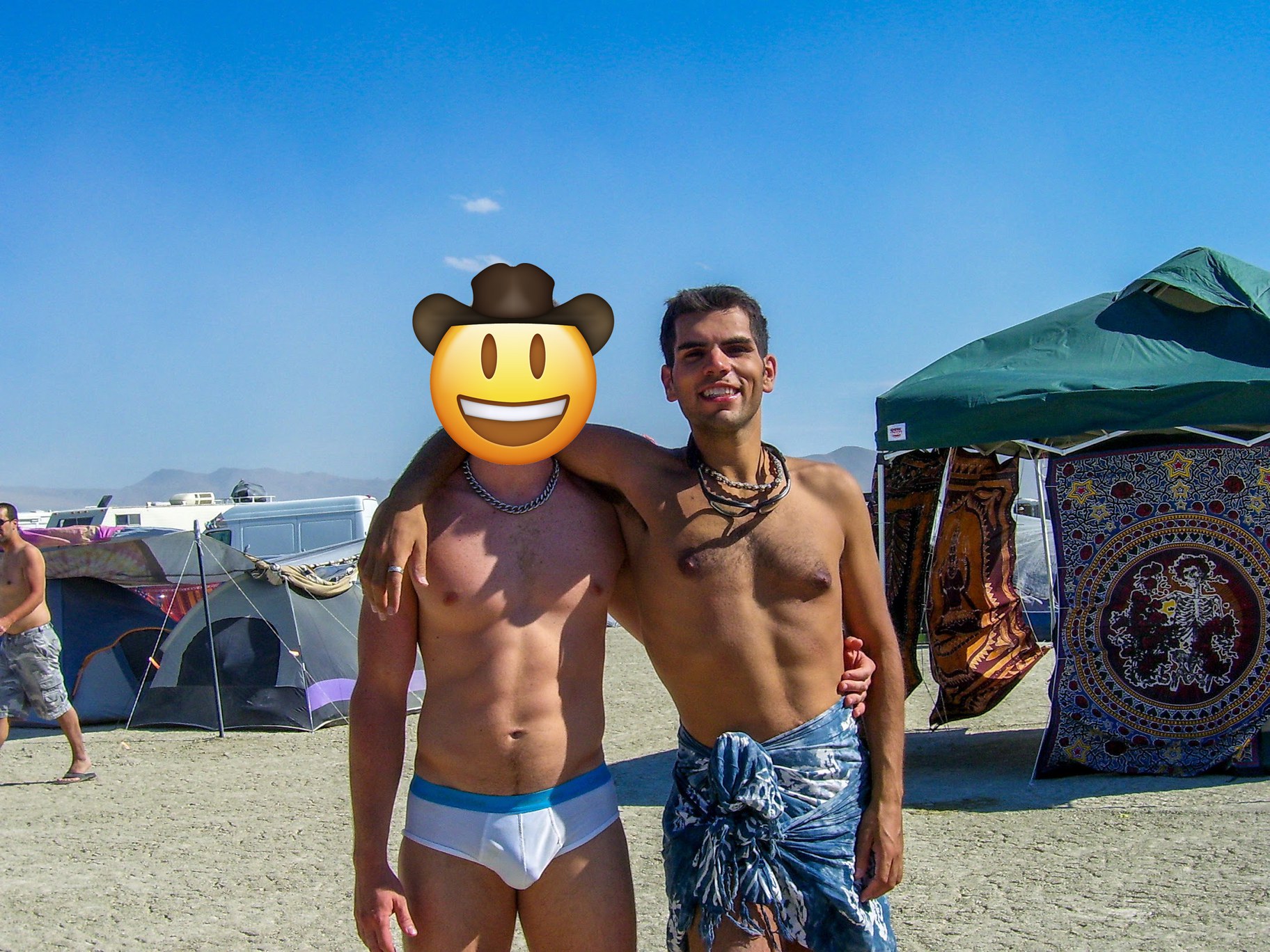
The author with a friend attending his first Burn in 2006. Photo courtesy Myke Dodge Weiskopf.
My first Burn was in 2006. I was 29 years old, living in Boston and working a straight gig in finance after expelling myself from the music industry. That spring, I met up with a cute aspiring acrobat on a popular hookup site of the time. A few months later, he invited me to Burning Man. The event, by then, was hardly a well-kept secret, but YouTube was in its infancy and iPhones were still another year away. Aside from the odd mention in popular culture, you couldn’t get a larger sense of Burning Man unless you chased down obscure documentaries, dropped hard money on art books, or (like me) got dragged out into the abyss with no hope of understanding what might become of you.
I confess with some mortification that I spent a chunk of that first Burn sitting in a rental SUV with the air conditioning on, listening to Bulgarian folk music and reading Joan Didion. Wherever my comfort zone was, it was far away from that place. But once the sun dipped below the mountains, the acrobat threw a headlamp on me, fed me a party favor, and took me out on the town.
Hopefully, reader, you have experienced a moment in your life when you felt your DNA being rearranged in real time. A moment when a crucial aspect of your consciousness is forever cleaved into the “time before” and the “time after.” For me, one such moment arrived the first night I stepped out onto Black Rock City’s main drag, the Esplanade.
“Time before”/“Time after”
By now, most folks in the default world can summon some idea of what Burning Man looks like: the vast sea of light and flame, the whimsical architecture, the relentless sense of movement and interactivity. Less familiar to the cultural imagination, but arguably as visceral and overwhelming, is what Burning Man sounds like — the aural contours that ground, connect you to, and immerse you in this otherwise ephemeral space.
My first encounter with the Esplanade was the most riotous, disorienting, and psychedelic sound I’ve ever experienced. Mutant vehicle sound systems criss-cross on the open playa, creating multiple simultaneous doppler effects. Bicycle bells, generators, bike chains, fire cannons, music of (almost) any genre: the sound ricochets off vehicles, structures, people, distant mountains. It melts and reverberates and changes color on the wind. It is overwhelmingly beautiful. In that moment, Black Rock City became one of my spiritual homes. As a field recordist, that sound has called me back, year after year.
These personal audio archives became an important lifeline during the peak pandemic years when Burning Man went dark for 2020 and 2021. I enjoyed modest backyard Burns while playing my ambient sounds for local flavor. I skipped last year’s “renegade Burn,” which was held without the official organization’s participation, so attending its formal return in 2022 was a foregone conclusion.
More: Listen to a 54-minute mix of Myke’s 2007-2019 Burning Man field recordings.
But it was impossible to ignore the fact that we were coming back to a changed world. We all had to re-learn how to be among one another, just as we had in our default lives. Everything had fallen by the wayside over the last two years: our sense of play, our physical endurance, our survival instincts, and much of our gear. I decided I had to go back to basics: No research, no photos, no scouring events or plotting schedules (but yes to volunteering). Not knowing what to expect, I wanted to fully invest in chance, and to capture the experience in real time.
Well, friend, the playa knows the difference between an intention and an expectation. Intentions are set and then released, with freedom to move within them. But expectations trap you in a fixed idea. They’re anathema to the immediacy that BRC demands. And if you roll up like a veteran in a comfortable groove, you become a prime candidate for some roughing-up by the playa gods.
First, it was hot this year. Thanks to an anomalous high-pressure weather system looming over the city, the triple-digit heat sat on you like a large and insolent cat, caring not for your welfare nor your plans. You could shuffle through any number of misting stations and cooling depots and be bone-dry and parched within a minute. For the “day Burners” among us, who thrive on their mornings and afternoons, this year was surely a hard one. Forget about long bike rides to look at the miles of art that await you. Nobody wants to drag your desiccated body into the Rampart medical center to be plugged into a saline bag. (Like any city, BRC has hospitals, post offices, a public works department … and a fairly vibrant porta-potty subculture.)
That scotched the daytime exploring and recording. But surely the nights? The preternaturally warm nights, when you could roam shirtless in shorts until dawn? It’s true, they were lovely. But just as one can’t exist solely after dark in one’s default life, there’s something disorienting about only experiencing BRC at night. For one thing, aside from the largest or most well-lit pieces, it’s hard to have any sense of the art. It’s trivially easy to explore the pieces closest to home, the ones you pass on any random night. But the perimeter of Black Rock City is seven square miles. And it’s packed not just with visual art, but also dance, opera, improv comedy, storytelling, live music, burlesque, circus arts… a million ways to distract, tantalize, and otherwise fuck with your so-called plans. It’s nice to have a loose notion of how your night is going to go, but “subject to change” here is a promise, not a stipulation.
The question it asks you, forcing you to answer.
Every year, my partner and I set aside one night to explore solo. This year, that night fell on a Thursday. Around 9:30 PM, I pack up my stereo field mic, hook up a fresh power brick, and set out on foot for a long sojourn to the darkest and most mysterious part of Black Rock.
An important note about BRC’s impermanent urban planning: Picture a city laid out like the face of a clock. The positions from 2:00 to 10:00 are the bounds of the metropolis itself. The streets run alphabetically in radial rows out to the southerly edges of the city. And the Esplanade is the frontage facing out to the open playa.
If “inner playa” is the vast area within the core of the city’s layout, then “deep playa” is the hinterlands, the outskirts, terra incognita. Its most iconic feature is the trash fence: seven miles of four-foot plastic netting that constrains the city’s perimeter (and also hopefully keeps too much detritus from blowing out to BLM land). On the other side of the trash fence is the remaining 97% of the Black Rock Desert. At any time of day, visiting the trash fence offers a profound sense of scale, but the nights in particular have a pitch-black barrenness that inspires a truly cosmic feeling. With only the faintest visible traces of nearby land formations, peering out into the open desert offers a tabula rasa for any frame of mind.
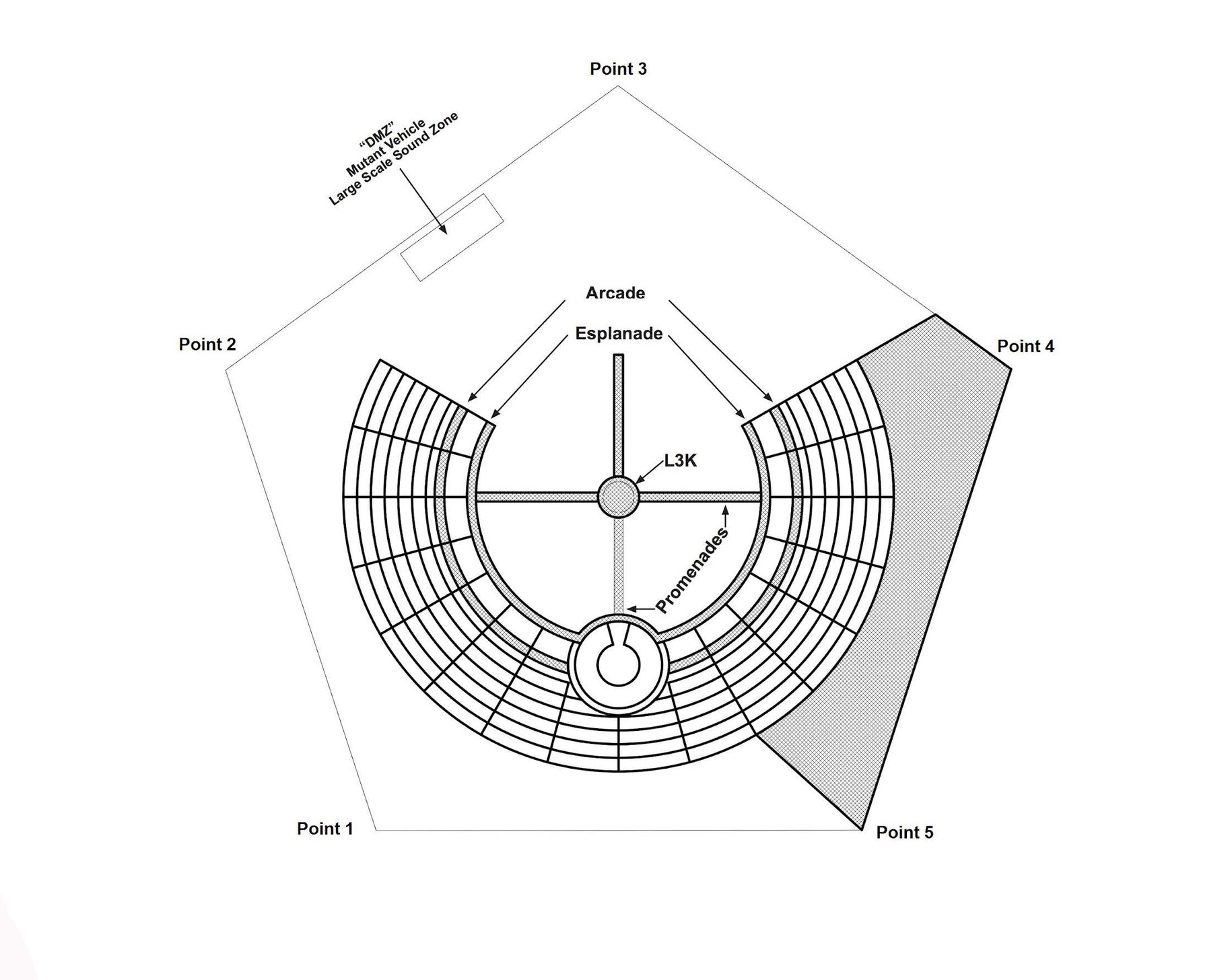
A diagram of Black Rock City details the site’s perimeter and structure. Image via Burning Man.
My intention is to walk from our camp (located at 4:45 and Esplanade) to my favorite spot in the whole of Black Rock City: Point 2.
To get to Point 2, you must walk out past the furthest edge of the 10:00 side. Here lies the last vestige of civilization: the so-called Hell Station, where gasoline, diesel, and propane are available to licensed parties throughout the event. It’s a good 90 minute walk from home to Hell Station, by which time the desert’s disquieting solitude has begun to seep into your bones. The station’s blank white lights feel almost Lynchian, hovering amidst so much negative space like the supernatural gas station of “Twin Peaks: The Return.”
As you trudge on, Hell Station falls into the distance as your senses gradually adjust to the near-total absence of input. Given the lack of other humans, the best course of action is to turn off your lights entirely and soldier on into the darkness. Once you hit the furthest corner of the trash fence, marked only by a single faint LED inside a balloon, you have reached Point 2.
Here, the primary sound is the distant thundering of hundreds of sound systems. They merge into a single vaporous organism as they propagate across the long atmospherics of the open playa. This vantage point affects the visuals as well: Looking back towards home, all of BRC is reduced to a long, thin horizon of pyrotechnics. Lasers beam out across the desert, creating dynamic waveforms of light over your head. Large explosions discharge soundlessly, their low-frequency booms absorbed into the cacophony. Only higher-frequency sounds pierce through: a vocal refrain, a drum fill, a big drop. Somewhere in there, you can sense the collective pulse of 80,000 people.
If I am lucky enough at life’s end to reflect on all the experiences of my time as a field recordist, the sound of deep playa may be the most profoundly affecting of all. “Everything looks perfect from far away,” went some twee old song once. And in deep playa, it’s true.
I meander out there for hours. A minor dust storm kicks up, turning the view from my head lamp into a snowy, impenetrable expanse. Eventually, I lose sight of the trash fence. I zig-zag around, doing my best to root out the smaller art pieces that people stash out here. Deep playa attracts a whole world of mischievous, lo-fi, and often unlit art that can be snarky (a giant, human-sized Tickle Me Elmo rendered in a Christ pose) or thoughtful (Last Chance Bike Repair, a small basket containing a complement of supplies for emergency repair in this far-flung zone).
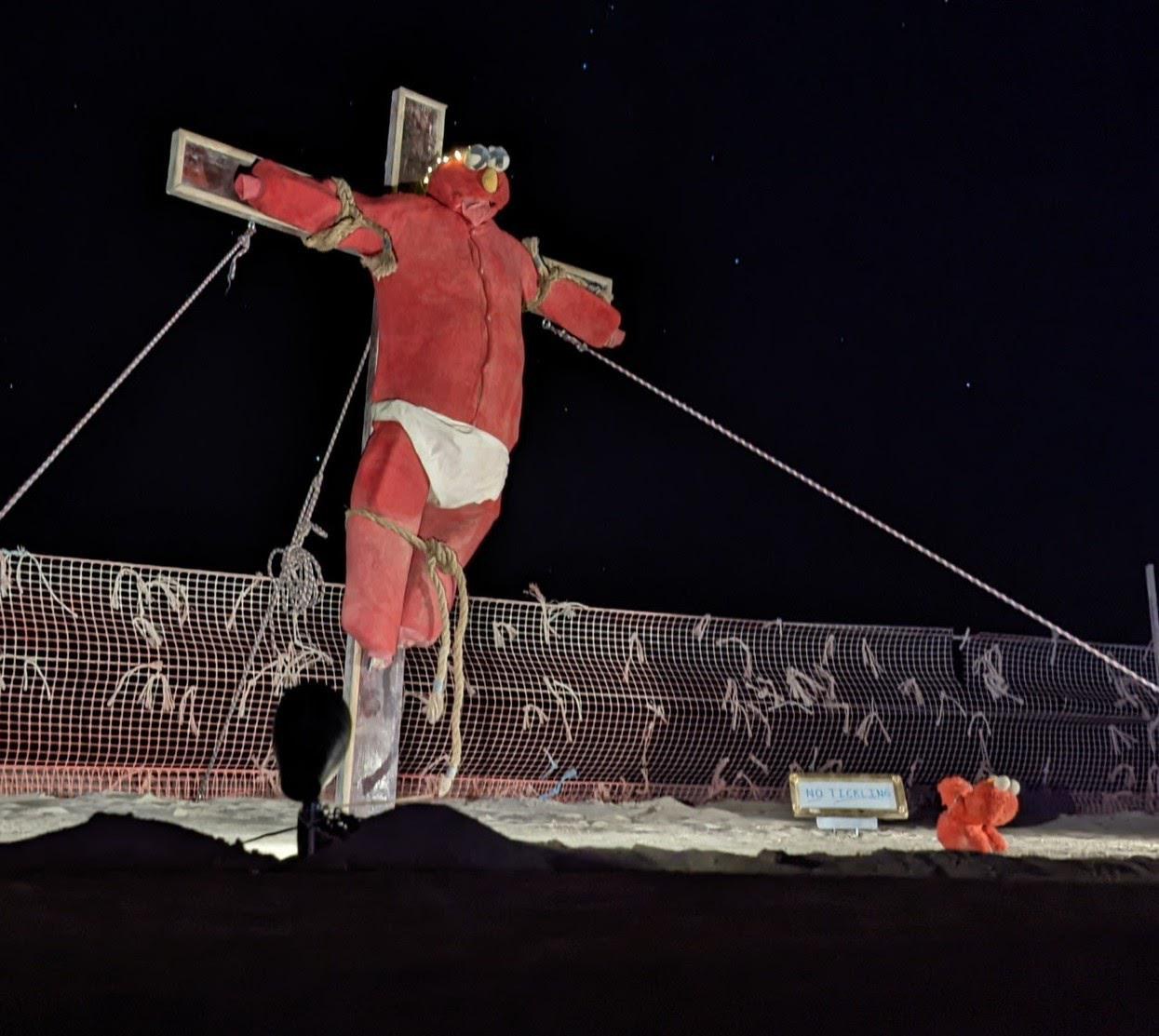
“No Tickling” a sign warns in front of deep playa art by Barry Brumitt. Photo courtesy the artist.
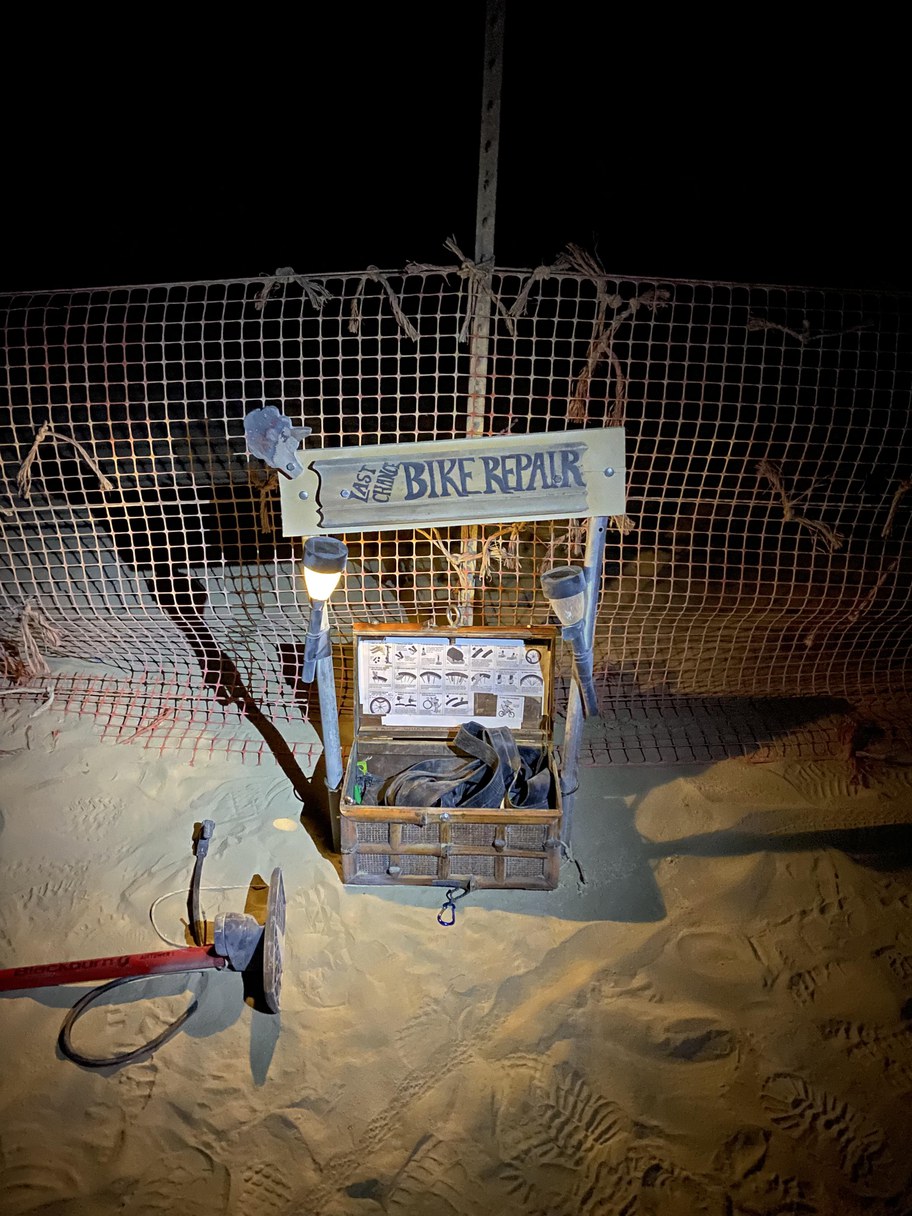
The Last Chance Bike Repair deep playa installation offers emergency repair supplies on the edges of the site’s perimeter. Photo by Roger Burton.
Deep playa is, for me, the true heart of Black Rock City, where the best stuff lies in wait with no particular effort to attract your attention. Perhaps that’s also how I like to think of myself out here.
Every city needs archivists, collectors of ephemera, keepers of the flame. For those of us who are passionate about our work, that impulse overrules all other experiences and considerations. There’s no greater pleasure than to meander around this temporary place, following the sound wherever it leads. Field recording is my way of gifting the city back to itself, long after the last of our physical traces have been packed out.
I roll back into camp sometime around 2:30 AM, my heart full and my mind erased. I triumphantly pull out my recorder to hit the stop button, only to find… a blank screen.
I check the battery: still three dots left. I push and pull at the cable connections. Then I spy the error message: CARD FULL.
Amidst the chaos and heat and overstimulation, I neglected to swap out the SD card in preparation for an all-night taping. Of my five-plus hours on foot, only 62 minutes survive.
What question is the playa forcing me to answer?
I look down at the lanyard around my neck, a laminated card bearing a media registration number. In the red glow of my head lamp, all other words dissolve, save for the department’s credo: “This Entitles You To Nothing In Particular.”
One might say the same of Black Rock City.
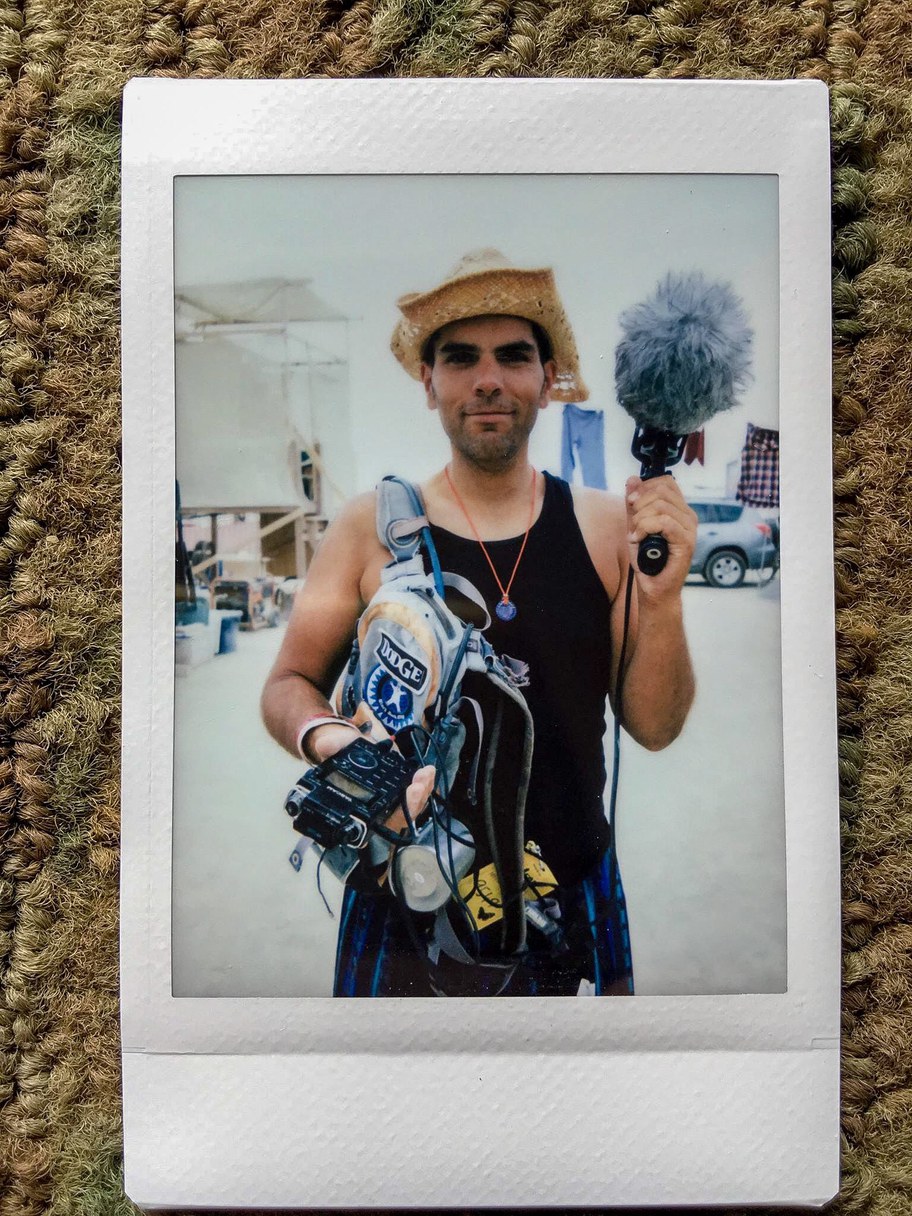
Myke Dodge Weiskopf poses with his recording equipment at Burning Man. Photo by Missy Bochatey.
AUDIO: BURNING MAN 2022 / Recorded and Mixed by Myke Dodge Weiskopf
00:00 - Saturday, 8/27: City opening as heard from staging area
00:30 - Monday, 8/29: Diva Marisa performs at the opening of Thunderdome
05:35 - Tuesday, 8/30: Carillon by Steven Brummond
08:00 - Wednesday, 8/31: Belle Harlo performs at BRC3PO
10:22 - Wednesday, 8/31: Playa ambience
10:52 - Wednesday, 8/31: Art Haus performs Terry Riley’s “In C” at Catharsis
13:16 - Wednesday, 8/31: Night roaming near 6:00 Portal
14:40 - Thursday, 9/1: Fortune teller at Paradisium
16:34 - Thursday, 9/1: Prairie of Possibilities by The Moonlight Collective
19:28 - Friday, 9/2: ILUMINA by Pablo González Vargas
23:15 - Saturday, 9/3: Deep playa ambience, 2:29 AM
27:35 - Monday, 9/5: Unidentified saxophonist near A Street and 4:45
FURTHER LISTENING: Listen to a 54-minute mix of Myke’s 2007-2019 recordings.
